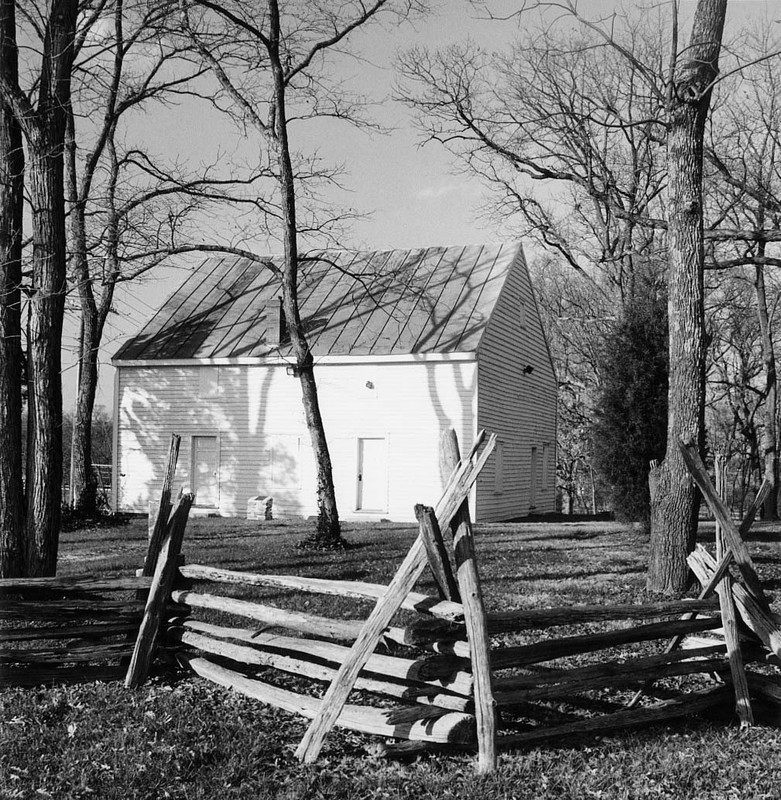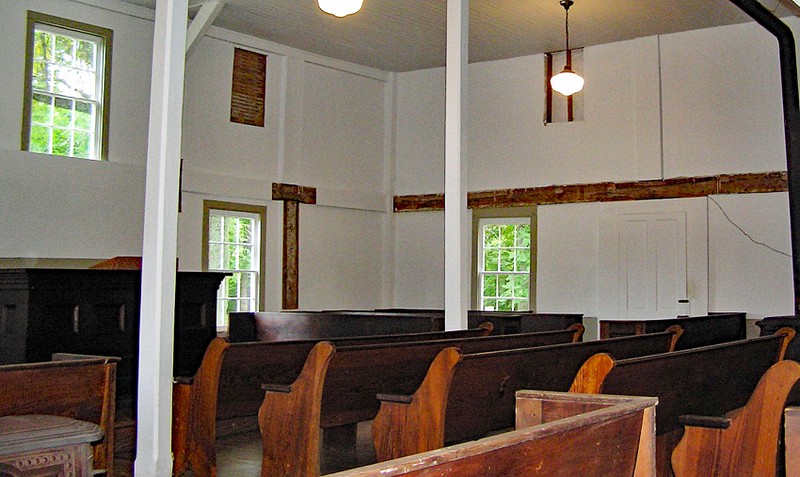Frying Pan Meetinghouse
Introduction
Text-to-speech Audio
Images
Frying Pan Meetinghouse, courtesy of Virginia Department of HIstoric Resources (reproduced under Fair Use).

Frying Pan Meetinghouse Interior, courtesy of Fairfax County Park Authority (reproduced under Fair Use).

Backstory and Context
Text-to-speech Audio
The plain, vernacular style of the one-room post-and-beam Frying Pan Meeting House (or Meetinghouse) reflect the values of simplicity in the Baptist faith. The Episcopal Church dominated religious life in early Virginia, and the architecture of the Frying Pan Meeting House represents a break with that tradition. On the site of the church is a cemetery and a baptismal pond in Frying Pan Spring. The meeting house and its grounds have remained mostly unaltered, with only minor renovations in the 1800s, and so the area has a high level of historic integrity.
Both free Blacks and enslaved individuals were part of the congregation; whites and Blacks worshiped together, were baptized together, and were buried together in cemetery. Church records cited in the National Register of Historic Places Registration Form note that in 1840, the racial composition of the congregation was nearly even, with 29 Black members and 33 white members.
Both Union and Confederate forces used the meeting house as a picket during the Civil War. Confederate soldiers camped on the grounds at times during 1861 and 1862. During the Civil War battle in Dranesville in 1862, the meeting house served as a hospital. It is therefore likely that soldiers who died are buried in the cemetery, but these graves are unmarked.
The meeting house was the only church known to have been built in Floris until the late nineteenth century. After 1867, African-Americans in the community organized their own congregation, building the Mount Pleasant Baptist Church in 1882.
Services continued at the meeting house until 1968. Arthur L. Carter, the last surviving member of the congregation, deeded the meeting house to the Fairfax County Park Authority in 1984. It stands on the larger Frying Park Farm Park, which preserves and interprets twentieth-century farm life. While the meeting house and grounds are not consistently open to the public, the Park Authority does offer tours upon request.
Other names for this structure are Frying Pan Baptist Church and Frying Pan Spring Meetinghouse. The "Frying Pan" name for the meeting house and surrounding farm come from a legend regarding settlers attacking Native Americans who were camping at the site and who left behind their frying pan.
Sources
Fairfax County Park Authority. Frying Pan Farm Park Meeting House, Accessed December 22nd 2019. https://www.fairfaxcounty.gov/parks/frying-pan-park/meeting-house.
Kell, Mary McCathan and Richard Sacchi. Frying Pan Meetinghouse, National Register of Historic Places Registration Form. December 20th 1990. Accessed December 22nd 2019. https://www.dhr.virginia.gov/VLR_to_transfer/PDFNoms/029-0015_Frying_Pan_Meetinghouse_1991_Final_Nomination.pdf.
Swain, Craig. Civil War at Frying Pan Spring Meeting House, Historical Marker Database. June 26th 2016. Accessed December 22nd 2019. https://www.hmdb.org/m.asp?m=64519.
Virginia Department of Historic Resources. 029-0015 Frying Pan Meetinghouse, Historic Registers. March 19th 2019. Accessed December 22nd 2019. https://www.dhr.virginia.gov/historic-registers/029-0015/.
https://www.dhr.virginia.gov/historic-registers/029-0015/
https://www.fairfaxcounty.gov/parks/frying-pan-park/meeting-house
